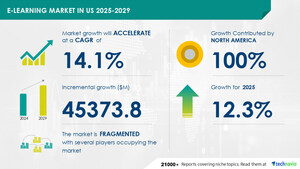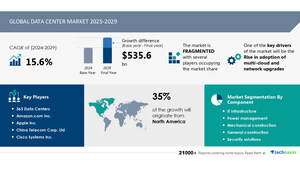NEW YORK, Feb. 29, 2024 /PRNewswire/ -- The seed treatment market is set to grow by USD 3,063.64 million from 2022 to 2027 progressing at a CAGR of 8.32% during the forecast period. The report offers an up-to-date analysis regarding the current global market scenario, the latest trends and drivers, and the overall market environment. The rising awareness regarding seed-applied technologies is driving market growth. The increasing demand for food is coinciding with a decline in per capita arable land availability, primarily due to population growth and urbanization. To enhance the efficiency of their farmlands, farmers are focusing on developing techniques like high-yield hybrid seeds for progressive food production. The utilization of treated seeds with extended shelf life and good quality becomes essential in this context. Government awareness programs, such as the India Seed Treatment Campaign, are also contributing to the growth of the seed treatment market during the forecast period. To tackle the challenges posed by limited land availability, vendors are continuously introducing high-yield hybrid seeds. In China, there is a particular emphasis on increasing yields per hectare through the introduction of new varieties that offer higher yields while requiring reduced water, fertilizers, and other inputs, and are more resistant to droughts, heat, submersions, pests, and diseases. Consequently, the combination of declining arable land and the development of treated crops is expected to drive the growth of the market during the forecast period. Download Sample Report in minutes!
Report Coverage |
Details |
Page number |
158 |
Base year |
2022 |
Historic period |
2017-2021 |
Forecast period |
2023-2027 |
Growth momentum & CAGR |
Accelerate at a CAGR of 8.32% |
Market growth 2023-2027 |
USD 3,063.64 million |
Market structure |
Fragmented |
YoY growth 2022-2023(%) |
7.5 |
Regional analysis |
North America, APAC, Europe, South America, and Middle East and Africa |
Performing market contribution |
North America at 36% |
Key countries |
US, China, India, Russia, and France |
The traditional strategies aimed towards developing innovative seed treatment products
Key players in the market are adopting various growth strategies, including acquisitions, partnerships, and collaborations, to expand their market presence and gain significant market shares. Both international and locally active players operate in the market under consideration. However, the prominent players strategically prioritize acquisitions and partnerships to enhance their position in the global seed treatment market. The partnership with Albaugh LLC, for instance, enables them to expand their portfolio of customized seed treatments, demonstrating their commitment to product innovation. These factors are expected to contribute to the growth of the global seed treatment market during the forecast period.
- The ban on chemical-based seed treatment solutions is a major challenge hindering market growth. Download Sample Report in minutes!
Market Segmentation
This report extensively covers market segmentation by crop type (oilseeds, cereals and grains, and fruits and vegetables), type (chemical and non-chemical), and geography (North America, APAC, Europe, South America, and the Middle East and Africa).
- The oilseeds segment will account for a major share of the market's growth during the forecast period. In the past 4-5 years, there has been a rising demand for oilseeds like soybean and rapeseed globally. This increasing demand for soybean and cotton seeds, which are among the most consumed crops worldwide, significantly contributes to the growth of the global seed treatment market. To meet the higher demand, oilseed producers have been increasing their productivity, leading to an expansion in the cultivation area for pulses and oilseeds, further driving the growth of the global seed treatment market in the oilseed segment during the forecast period. View Sample Report
Companies Mentioned
- AGLUKON Spezialduenger GmbH and Co. KG
- Albaugh LLC
- Associated British Foods Plc
- BASF SE
- BioWorks Inc.
- Excel Crop Care Ltd.
- FMC Corp.
- Humintech GmbH
- Koch Industries Inc.
- MITSUI and CO. LTD.
- Novozymes AS
- Nufarm Ltd.
- OMEX
- Plant Health Care Plc
- Roquette Freres SA
- Sumitomo Chemical Co. Ltd.
- Syngenta Crop Protection AG
- UPL Ltd.
- Bayer AG
- Corteva Inc.
Companies Offerings
- AGLUKON Spezialduenger GmbH and Co. KG - The company offers seed treatment that helps to boost root development, germination, and uniform emergence.
- BASF SE - The company offers seed treatment solutions such as corn, soybean, and cereals.
- Associated British Foods Plc - The company offers seed treatments such as seed polymers and bespoke solutions under its subsidiary Germains Seed Technology. Technavio's SUBSCRIPTION platform
Analyst Review
In the agriculture, where farmers tirelessly toil to meet the world's growing demand for food, the seed treatment market plays a pivotal role in ensuring crop productivity and minimizing losses due to various factors such as pest infestations, fungal diseases, and abiotic stresses.
Seed treatment involves the application of insecticides, fungicides, and other chemicals to seeds before planting, thereby protecting them from soil-dwelling insect pests, nematodes, and seed-borne diseases. Syngenta Group, a key player in this market, provides a range of seed treatment chemicals containing active ingredients like Metalaxyl, Carbendazim, Thiram, Captan, Imidacloprid, Clothianidin, Thiamethoxam, Fipronil, and Chlorpyrifos. These potent chemicals not only combat pests but also enhance abiotic stress tolerance in crops, helping them withstand droughts, heatwaves, and other adverse environmental conditions.
Farmers, facing constant challenges from crop diseases and pest control, rely on seed treatments to safeguard their seedlings during the preharvest stage and throughout the crop cycle. By employing fungicidal seed treatments containing Tricyclazole and other agents, they effectively manage fungal diseases like rice blast, ensuring healthy plant establishment and maximizing rice yield.
In addition to protecting seeds from pests and diseases, seed treatments contribute to sustainable farming practices by reducing the need for chemical sprays post-planting, thus minimizing environmental impact. This approach aligns with the goals of governments and extension services worldwide, which often support such initiatives through subsidies and awareness campaigns aimed at promoting industry collaborations for sustainable agriculture.
Furthermore, seed treatments target a diverse range of pests, including sucking insects like wireworms, seed-corn maggots, grubs, caterpillars, and beetles, thereby ensuring optimal crop production and minimizing crop losses due to pest damage.
Overall, the seed treatment market continues to evolve, driven by advancements in chemical formulations, technological innovations, and increasing awareness among farmers about the benefits of seed treatment. As agriculture faces new challenges in the form of climate change and evolving pest pressures, the role of seed treatments in safeguarding crop yield and enhancing food security remains indispensable. View Sample Report
Related Reports:
The genetically modified (GM) seeds market is estimated to grow at a CAGR of 10.69% between 2022 and 2027. The size of the market is forecast to increase by USD 18.38 billion. This report extensively covers market segmentation by product (corn, soybean, cotton, canola, and others), type (herbicide tolerance and insect tolerance), and geography (North America, APAC, Europe, South America, and the Middle East and Africa). The rise in the adoption of biofuels is notably driving the market growth.
The chemical seed treatment market share is expected to increase to USD 3.39 billion from 2021 to 2026, and the market's growth momentum will accelerate at a CAGR of 9.64%. This report extensively covers chemical seed treatment market segmentation by type (insecticides, fungicides, and others) and geography (APAC, North America, Europe, South America, and the Middle East and Africa). One of the key factors driving the global chemical seed coating treatment market growth is the increased use of herbicides.
Key Topics Covered:
1 Executive Summary
2 Landscape
3 Sizing
4 Historic Size
5 Five Forces Analysis
6 Segmentations
7 Customer Landscape
8 Geographic Landscape
9 Drivers, Challenges, and Trends
10 Vendor Landscape
11 Vendor Analysis
12 Appendix
About US
Technavio is a leading global technology research and advisory company. Their research and analysis focuses on emerging market trends and provides actionable insights to help businesses identify market opportunities and develop effective strategies to optimize their market positions. With over 500 specialized analysts, Technavio's report library consists of more than 17,000 reports and counting, covering 800 technologies, spanning across 50 countries. Their client base consists of enterprises of all sizes, including more than 100 Fortune 500 companies. This growing client base relies on Technavio's comprehensive coverage, extensive research, and actionable market insights to identify opportunities in existing and potential markets and assess their competitive positions within changing market scenarios.
Contact
Technavio Research
Jesse Maida
Media & Marketing Executive
US: +1 844 364 1100
UK: +44 203 893 3200
Email: [email protected]
Website: www.technavio.com
SOURCE Technavio

WANT YOUR COMPANY'S NEWS FEATURED ON PRNEWSWIRE.COM?
Newsrooms &
Influencers
Digital Media
Outlets
Journalists
Opted In





Share this article